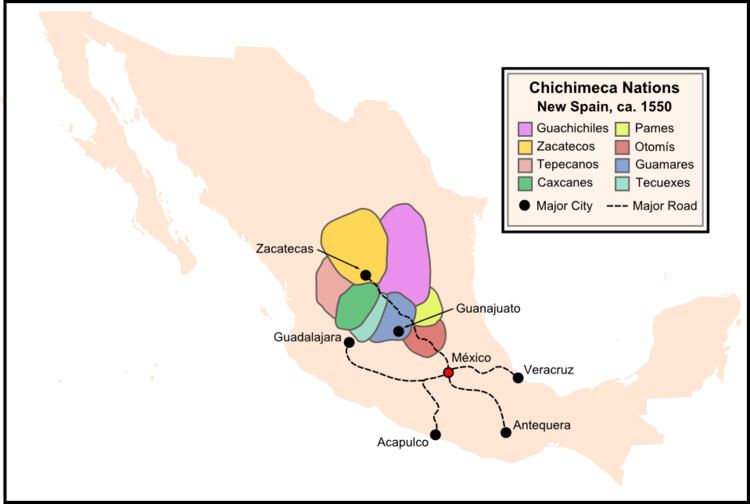 | ||
The Tecuexe were an indigenous peoples of Mexico, who lived in the eastern part of present-day Guadalajara.
Contents
History
It is believed that the Tecuexe derived from the dispersion of Zacateco groups from La Quemada. Like the Zacatecos, the Tecuexe were a tribe belonging to the generic "Chichimeca" peoples. It is known that they settled next to rivers which they used to their advantage to grow beans and corn. They were also expert artisans, carpenters and musicians. Toribio de Benavente Motolinia wrote "in any place… all know to work a stone, to make a house simple, to twist a cord and a rope, and the other subtle offices that do not require instruments or much art." The Tecuexe were known for their fierceness and cruelty towards their enemy. They were known to be so brave, it is said, that once, when the Mexica (Aztecs) came from Chicomostoc, Zacatecas to take control of Xolotl, (and course on to the lagoon where they found an eagle devouring a serpent) they attacked the settlers of Acatic, Teocaltiche, Mitic, Teocaltitán and Xalostotitlán, but in Tepatitlán, when they encountered the Tecuexe, having heard of their legendary cruelty, the Mexica avoided facing them.
The Tecuexe wore dresses with classic tilmatl (tilma) and huipilli, worn with comfortable cactlis and adorned their bodies with necklaces, bracelets, earrings and nose rings that they themselves made. They liked to make their houses in valleys and gorges near rivers, always in a position ready to battle. They also had temples in Teocaltiche, San Miguel el Alto, Jalostotitlán, Teocaltitan de Guadalupe and possibly in Tepatitlán.
Spanish Conquest
They were conquered by Captain Nuño Beltrán de Guzmán who began his siege on December 21 of 1529. His army consisted of 200 Spaniards on horse, 300 infantry on foot, 10,000 Mexicas (Aztecs) and 10,000 Tarascos and Tlaxcaltecas who had switched to the Spanish side. In the fight many died, some took refuge in the mountain areas and those that remained in the plains were enslaved and forced into hard labor. About ten years later they took revenge. They were one of many tribes who fought under Tenamaxtli in the Mixton rebellion (1540–41). It is said that about 100,000 natives were gathered on the Mixton Mountain, ready to end Spanish rule, and that behind every stone, land, tree or brush was a native Caxcán, Tecuexe, Coca or Chichimeca, ready to subdue the invaders.
The Last of the Tecuexe
The last Tecuexe chief is said to be Chapalac, who the lake of Chapala is named after. In the end the Spanish power won, but some natives, rather than surrendering and being enslaved, threw their women and their children head first off the cliffs. This was soon stopped by Franciscanos. Fray Antonio de Segovia who took in his hands the venerated image of the Virgin of Zapopan. Acts like these are considered in parallel to Leónidas and his 300 soldiers who died fighting until the last man. After enslavement it is said that by 1854 no one in the tribe could speak their native language, and much of their identity was forgotten. Although today some indigenous tribes remain, they no longer exist as a cultural group.
Language
The Tecuexe language is now extinct and very little is known about it. It may have been an Uto-Aztecan language.
